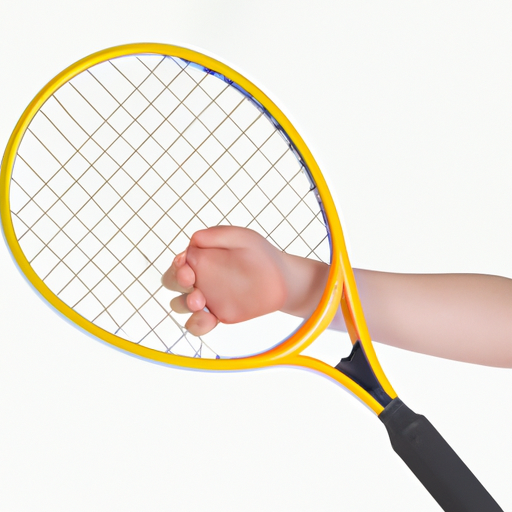Are your little ones eager to hit the tennis court and perfect their swing? If so, it’s essential to make sure they have the proper grip on their tennis racket. But with so many different grip options out there, how do you know which one is best for your child? In this article, we will break down the different types of grips available for young tennis players, helping you find the perfect fit for your child’s racket. So, grab a seat and get ready to learn about the proper grip for a child’s tennis racket!
Importance of Proper Grip
Having a proper grip on a tennis racket is essential for several reasons. First and foremost, it helps prevent injuries. When you hold the racket incorrectly, you put yourself at risk of developing strains or even more serious conditions such as tennis elbow. Secondly, a correct grip improves your control over the racket and allows for better accuracy in your shots. With the right grip, you can generate more power and have a better feel for the ball, leading to more consistent and effective strokes.
Choosing the Right Grip Size
The size of the grip is an important aspect to consider when selecting a tennis racket for a child. Using the correct grip size ensures that the child can hold the racket comfortably, which is crucial for their overall technique and performance. A grip that is too large can hinder their ability to move the racket freely, while a grip that is too small can result in a lack of control and stability. It is essential to find the right balance to maximize the child’s potential on the court.
Basic Fundamentals of Grip
There are several common grips used in tennis, each with its own advantages and applications. The Eastern forehand grip is the most commonly used grip for hitting forehand shots. It involves placing the base knuckle of the index finger on the third bevel of the racket handle. The Continental grip, also known as the handshake grip, is used for volleys, serves, and overhead shots. It entails positioning the base knuckle of the index finger on the second bevel. Lastly, the two-handed backhand grip is employed when hitting backhand shots with both hands on the racket handle. It provides stability and control, especially for younger players still developing their strength and coordination.
Teaching Techniques for Young Players
When teaching young players, visual aids can be a powerful tool for conveying the importance of a proper grip. Using images or videos of professional players illustrating correct grip techniques can help children understand the correct hand placement and position. Additionally, providing hands-on guidance is crucial. Physically adjusting their grip and guiding their hand placement can help children develop muscle memory and reinforce the proper grip technique. Finally, it is important to reinforce the proper grip through practice. Incorporating specific drills and exercises that focus on grip technique can help young players develop and maintain a correct grip.
Drills and Exercises to Develop Grip Strength
In addition to teaching correct grip technique, it is important to develop grip strength to enhance performance on the tennis court. Finger squeezing exercises are a simple and effective way to strengthen hand muscles. These exercises involve squeezing a soft ball or grip ring with the fingers for a set number of repetitions. Another option is using grip strengthening tools such as grip strengtheners or hand grippers. These tools provide resistance that challenges the hand muscles and helps improve grip strength. Finally, incorporating grip strength into tennis drills can be beneficial. This can be done by using tennis-specific grip strengthening exercises within regular training routines to ensure that grip strength is developed in tandem with other tennis skills.
Common Grip Mistakes to Avoid
There are a few common mistakes that players, especially younger ones, tend to make when it comes to their grip. Gripping the racket too tightly is a widespread error that can restrict wrist movement and lead to muscle strain. Encouraging players to maintain a relaxed but secure grip can help prevent this issue. Conversely, gripping the racket too loosely can result in a lack of control and stability. It is important to find the right balance between a grip that is firm enough to maintain control without being too tight. Additionally, incorrect hand placement can significantly impact the effectiveness of shots. Ensuring that the player’s hands are correctly positioned on the racket handle is essential for optimal performance.

Different Types of Grips for Specific Shots
Different shots in tennis require specific grips to maximize their effectiveness. The serve grip, for example, involves adopting a Continental grip to provide more power and control for serving. The Continental grip allows for a better angle of the racket face when making contact with the ball, resulting in more effective serves. The volley grip, on the other hand, is also a Continental grip but with a slightly modified hand position. It allows for quick reactions and a firm and stable volley. Lastly, the slice grip is commonly used when executing slice shots, such as backhand slices or drop shots. It requires using a modified Eastern forehand grip to enhance control and spin.
Adapting the Grip as the Child Grows
As children grow physically, their grip size will naturally change. It is important to monitor their grip size regularly to ensure that they continue to use the correct grip size. If their hand outgrows the current grip size, it is crucial to transition them to a larger grip. Using a racket with an inappropriate grip size can hinder their progress and lead to bad habits. It is important to consult with a knowledgeable coach or professional to determine when it is time to transition to a larger grip and make the necessary adjustments.
Techniques for Overcoming Grip Fatigue
Grip fatigue can be a common issue, especially during long matches or intense training sessions. To overcome grip fatigue, proper rest and recovery are essential. Allowing the hand muscles to rest and restore their energy is crucial for maintaining a strong and secure grip. Additionally, strengthening hand muscles through exercises can help improve endurance and reduce fatigue. Incorporating finger and wrist exercises specifically designed to target the muscles used in gripping can contribute to better grip stamina and overall performance on the court.
Conclusion
Learning and maintaining a proper grip is of utmost importance in tennis. It not only helps prevent injuries but also improves control and accuracy. Choosing the right grip size for a child’s tennis racket is vital to ensure their comfort and performance. Teaching the basic fundamentals of grip through visual aids, hands-on guidance, and practice is crucial for young players’ development. Incorporating drills and exercises to develop grip strength can enhance overall performance on the court. Avoiding common grip mistakes, using different grips for specific shots, and adapting the grip as the child grows are all essential aspects to consider. Overcoming grip fatigue through proper rest and recovery, as well as strengthening hand muscles, can help maintain a strong and secure grip. Continuous practice and guidance are key to developing and improving grip technique throughout a player’s tennis journey.


